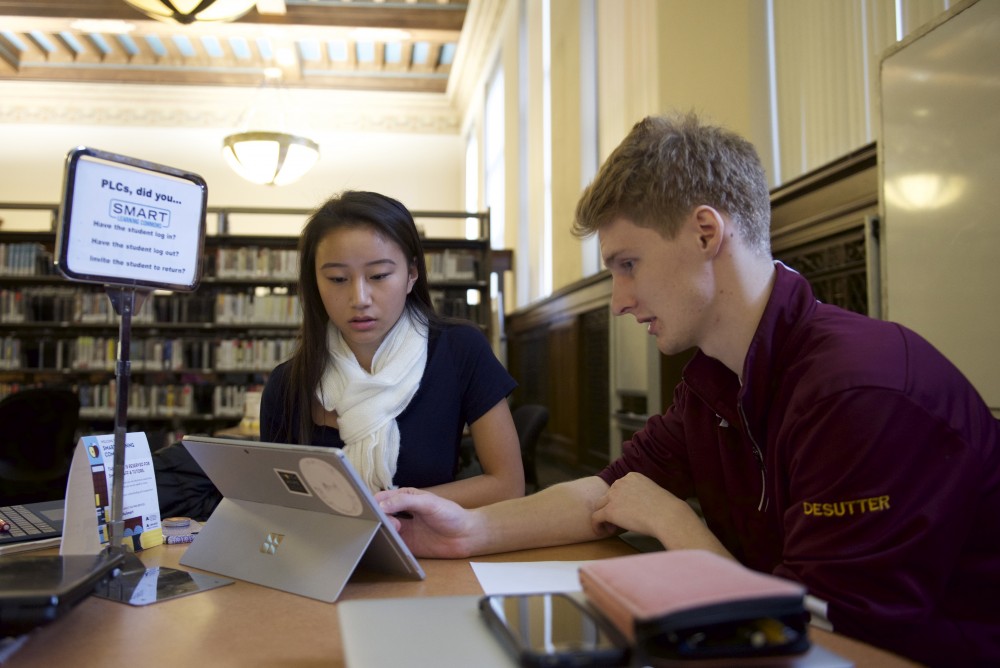Peer tutoring in the SMART learning commons at the University of Minnesota’s library system has never been so busy.
If current trends hold, fall 2017 could be the most trafficked semester based on numbers dating back to 2010 for the free learning resource.
Since Sept. 5, tutors in Wilson, Walter and Magrath libraries have already seen more visits than fall, spring and summer of the 2016-17 academic year combined.
Brett Gray, individual learning services coordinator with SMART learning commons, oversees the peer tutoring program and started his position on Jan. 30 with hopes to make sure students were aware of the campus resource.
Without a single factor to pin down the spike in traffic this semester, Gray attributes the visits to increased outreach, education, tweaking of program services and talented tutors.
“Sometimes the professors make it extremely difficult to bring it down … to a student level understanding,” said tutor Noah DeSutter, who has been with the program since fall 2016. “I think as tutors, we kind of bridge that gap.”

SMART hires 35 to 40 paid undergraduates each semester who maintain a GPA of 3.2 or higher. The 36 tutors on staff this year tutor for classes in which they received an A. Altogether, the tutors support more than 200 different classes.
Brett Peterson, a chemical engineering junior, and Elsa Hauschildt, a mechanical engineering junior, said they both feel that peer tutors can explain subject matter in a more approachable way than TAs or professors.
“[Some professors] understand it too well, and they can’t dumb it down,” Hauschildt said.
Peterson and Hauschildt used peer tutoring help with Physics I when they were freshmen.
“I just felt like [peer tutors] had a better understanding about answering questions that we were given, because they can explain it on a level that we can understand,” Peterson said.
Forty percent of students who come for tutoring are second-semester freshmen or first-semester sophomores, Gray said.
“I started pretty behind on math, so being able to come here and talk about calculus or … advanced math was really helpful,” said Joe Carlyon, undeclared sophomore and recent transfer student.
More than 25 percent of tutoring services are devoted to Calculus I, the tutoring program’s most requested course.
“I don’t have a lot of resources otherwise,” Carlyon said. “The U is really good about letting you know about these things.”
Holly Williams, a senior in accounting and information management systems, has been a tutor for math, economics and writing for two and a half years. Williams said she notices many students return for tutoring.
“It’s great when people come to you and they… are really unsure of their material and then they walk away feeling like they learned something,” Williams said.
Students can schedule one-on-one appointments with tutors in Magrath and Walter libraries, a new aspect of the program this fall that many think contributes to its increased traffic.
This fall also marked the first time students could book one-on-one evening appointments between 6:30 and 8:30 p.m. in Walter, an initiative in part supported by the Office of Undergraduate Education.
So far this semester, the late-night sessions are usually booked two weeks in advance, Gray said.
Despite the spike in traffic, many said they feel like there is a stigma surrounding tutoring on campus and nationwide.
Gray said he has been long aware of the stigma about tutoring.
“We’re conditioned when it’s okay to ask for help in certain areas, but when it comes to mental health, when it comes to academic success, for some reason we’re not willing to do that,” Gray said.
He added he hopes barriers that keep students from entering the tutoring commons continue to break.
“I love it when you see someone come in and they’re absolutely terrified because they have an exam,” DeSutter said. “When they finally get that ‘aha’… moment from understanding something, it’s really nice to be able to help them reach that point.”








